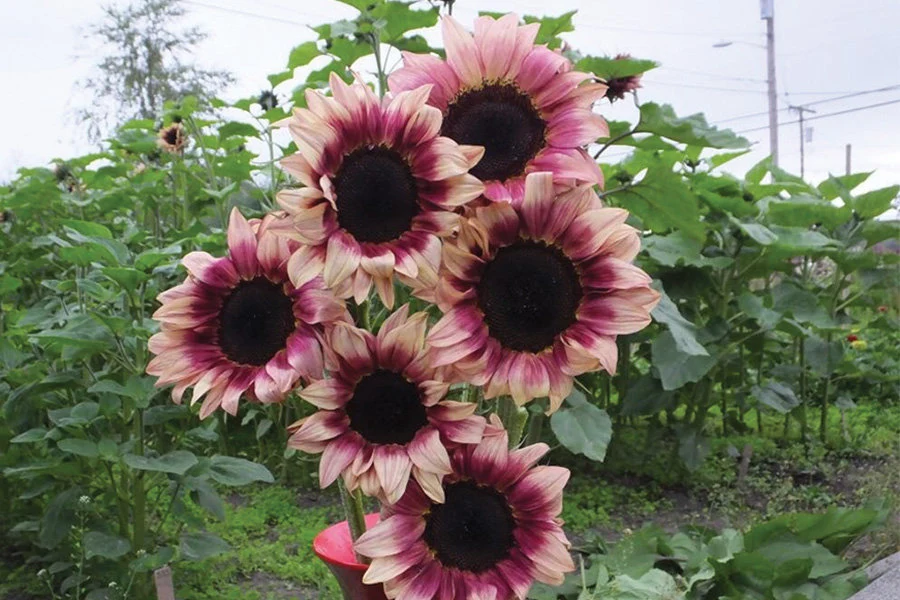Overview
- Common Name: ProCut Plum Sunflower
- Botanical Name: Helianthus annuus
- Type: Annual
- Mature Height: 5 to 6 feet
- Bloom Size: 4 to 6 inches
- Days to Maturity: 50–60 days from sowing
- Bloom Time: Mid to late summer
- Flower Color: Deep plum to rose tones with creamy or pale yellow highlights
- Sun Requirements: Full sun
- Hardiness Zones: Grown as an annual in all USDA zones
- Special Traits: Pollenless (ideal for cut flowers), uniform blooming, fast-growing
Description
The ProCut Plum Sunflower is part of the highly regarded ProCut series, bred specifically for the cut flower market. What sets this variety apart is its rich, moody coloration—a blend of muted purples, dusty pinks, and creamy centers that offer a dramatic alternative to the traditional yellow sunflower. With a single sturdy stem, no branching, and a pollen-free bloom, ProCut Plum is a florist’s dream.
Whether you’re growing for farmers markets, bouquets, or simply to elevate your summer garden, this sunflower delivers bold impact with minimal fuss.
Planting Instructions
When to Plant
- Direct sow after the last frost date in your area, when the soil has warmed to at least 60°F.
- For successive blooms, sow new seeds every 7–10 days for a few weeks.
Where to Plant
- Choose a site with full sun—at least 6–8 hours per day.
- Ensure soil is well-draining and fertile.
How to Plant
- Sow Depth: ½ inch deep
- Spacing: 4–6 inches apart for cutting gardens, 12–18 inches for landscaping
- Row Spacing: 12–24 inches apart
- Thin seedlings if needed once true leaves appear.
Sunflowers do best when direct seeded; transplanting can stunt their growth or cause stress due to their taproot system.
Soil Requirements
Sunflowers are adaptable but perform best in:
- Loamy or sandy soil
- pH 6.0 to 7.5
- Moderate organic matter content
Work compost or aged manure into the soil before sowing to encourage vigorous growth.
Watering
- Water deeply but infrequently, encouraging deep root development.
- Aim for 1 inch of water per week (rainfall or irrigation combined).
- Avoid soggy conditions, especially in early growth stages.
Once established, sunflowers are fairly drought tolerant, but consistent moisture ensures better stem strength and flower quality.
Fertilization
- Optional in rich soils, but beneficial for flower production in poor soil.
- Apply a balanced fertilizer (10-10-10) at planting time.
- A side-dressing of compost or a diluted liquid fertilizer can be added midway through the season.
Avoid over-fertilizing, particularly with nitrogen, which can cause tall plants with small blooms.
Support and Staking
- ProCut varieties have strong, straight stems, but if grown in windy areas or loose soil, light staking may be necessary.
- If spacing plants closely for cut flowers, the group planting often supports itself.
Pests and Diseases
Common Pests
- Aphids: Can distort leaves and flower heads; treat with insecticidal soap or strong sprays of water.
- Cutworms: Protect young seedlings with collars.
- Birds and squirrels: May go after developing seeds. Netting or row covers can help.
Diseases
- Powdery mildew: More common in humid conditions; space plants properly and water at the base.
- Rust or leaf spot: Ensure good air flow; remove affected leaves.
Good crop rotation and clean-up of old plant debris can prevent many issues.
Harvesting for Cut Flowers
ProCut Plum is bred specifically for the cut flower industry, which means:
- Pollenless blooms: No mess on clothes or surfaces, and longer vase life.
- Uniform bloom timing: Makes it ideal for market or bouquet planning.
When to Harvest
- Cut when the first ring of petals begins to open, but before it’s fully expanded.
- Cut in the early morning for best turgor (firmness).
- Immediately place in cool water.
Vase Life
- Typically lasts 5 to 7 days.
- Use a clean vase, fresh water, and flower preservative if available.
Succession Planting
For ongoing blooms:
- Sow a new batch every 1 to 2 weeks, up until about 70 days before your average first fall frost.
Because ProCut sunflowers bloom all at once and don’t branch, succession planting is key for a continuous harvest.
Landscape and Garden Use
While ProCut Plum is perfect for cutting, it’s also excellent in:
- Mass plantings
- Pollinator gardens
- Backdrops in borders
- Wildflower meadows (in combination with pastel or burgundy tones)
Even without pollen, these sunflowers still attract butterflies and bees thanks to their nectar-rich blooms.
Saving Seeds
Because ProCut Plum is a hybrid variety, seeds saved from it will not grow true to type. If you’re looking to maintain that signature color and form, it’s best to purchase fresh seeds from a reliable seed supplier each year.
Final Tips for Success
- Sunflowers follow the sun—so plant where their faces will be visible from your main viewing angle.
- Keep the area weed-free, especially in the first few weeks while plants are establishing.
- If you’re growing for market or events, consider combining ProCut Plum with white, cream, and deep burgundy varieties for a high-end floral palette.
- They’re also beautiful when dried, though color will fade slightly over time.
Summary Table
| Attribute | Details |
|---|---|
| Type | Annual |
| Height | 5–6 feet |
| Bloom Size | 4–6 inches |
| Bloom Color | Plum/rose with cream tones |
| Days to Bloom | 50–60 days |
| Sun | Full sun |
| Soil | Well-draining, moderately fertile |
| Water | 1 inch/week |
| Spacing | 4–6 inches (cutting), 12–18 inches (landscape) |
| Special Traits | Pollenless, single stem, fast-growing |


